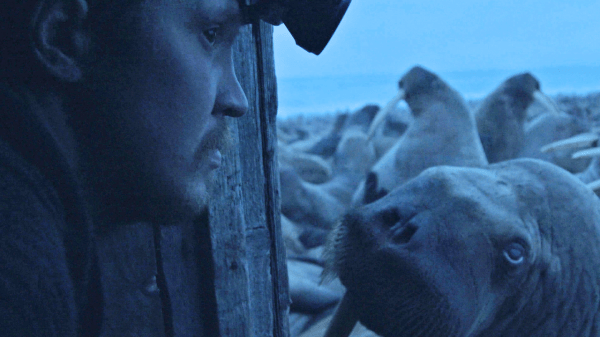
“This is irreversible, and the beginning of something really scary for this animal,” Evgenia Arbugaeva said, of climate change and its consequences on the Pacific walrus population.
In 2018, in the Siberian Arctic, the filmmakers Evgenia Arbugaeva and Maxim Arbugaev, who are sister and brother, arrived on a strange beach. “The sand was of dark colour, full of bones, and smelled terrible,” Arbugaeva recalled. Arbugaeva was working on a photography project about an Indigenous Chukchi community that practices subsistence hunting (whales, walruses, and seals, following the international quotas), and the siblings were on a hunt, at sea, when they landed on the beach. “In the middle of it stood the old hut,” Arbugaeva added. The hunters said that over the past decade, a young scientist had lived in the hut for several months out of each year, among thousands of walruses. “We were intrigued,” Arbugaeva wrote. They returned the following year to meet the scientist, a marine biologist named Maxim Chakilev, and take some photographs. “It was really overwhelming,” Arbugaeva said. “I was completely shocked by what I saw.”
The phenomenon that the Arbugaev siblings witnessed on that visit is the subject of their documentary, “Haulout,” which they filmed in 2020. The beach is situated in the remote region of Chukotka; to get there, they flew from Moscow to Anadyr, Chukotka’s capital, then took a small plane to the town of Lavrentiya, then took a passenger helicopter, which flies only once a month, to the tiny village of Enurmino, then caught a nine-mile boat ride with local hunters to the walrus beach, called Cape Serdtse-Kamen, which translates to Cape Heart-Stone. After arriving in mid-August, the Arbugaevs stayed for the entirety of Chakilev’s field season, until the first week of November, when the temperature was below zero degrees Celsius. They are accustomed to such conditions, having grown up in the tundra of Tiksi, in Yakutia, which neighbors Chukotka. “It’s kind of feeling like being at home,” Arbugaeva said.
The New Yorker Documentary
View the latest or submit your own film.

Arbugaeva had worked previously as a photographer; “Haulout” is her film début. Arbugaev was a professional hockey player for fifteen years before he started making movies. (“It’s actually really helpful,” Arbugaeva said. “Physically, he is quite strong and has endurance for shooting in harsh conditions.”) Together, they’ve been covering stories about the Arctic for more than a decade. “Increasingly, these stories become about the tragedy of climate change,” Arbugaeva said. But, for this film, “it was such a visceral experience,” she said. “This is irreversible, and the beginning of something really scary for this animal.”
Historically, walruses rarely ventured onto land. They would rest on ice floes near the fields of molluscs that they dive to eat. Arbugaeva said that Chukchi hunters remember a time when the sea’s horizon would be black from all the walruses resting on the floating ice. But in recent years, with warming waters, the sea has been free of ice, and too many walruses are forced to haul out onto the beach. Since Chakilev started his observations, in 2011, there has been an enormous number of walruses hauling out: he estimates about eighty per cent of the entire Pacific walrus population. The closest mollusc fields are about a hundred miles away, Arbugaeva said, so the walruses “have to make a lot of effort to feed, and return to the beach quite exhausted.” In 2020, the year they filmed, there were record-high temperatures, and a record-high number of walrus deaths.
During the three-month shoot, the Arbugaevs lived with Chakilev in the beach’s tiny wood hut. They were surrounded by walruses on three occasions, when the animals were so tightly packed that the group was unable to leave the hut at all, each time for about a week. A walrus, on average, weighs about two thousand pounds. In 2019, the first time the siblings experienced it, the walruses surrounded them in the course of a single night, nearly bursting into the hut by dawn. Arbugaeva’s brother woke her up; he was pacing and breathing heavily. “I’ve never seen anything like that,” she told me. “The light was so surreal, very blue, it was all very dreamy.”
At times the claustrophobia intensified. “The smell of ammonia, excrement, and rotting flesh was excruciating,” Arbugaeva said. Her eyes constantly watered. The noise was constant, too, making it hard to sleep. “It sounded like an army of orcs from ‘Lord of the Rings,’ ” she said. Because it was so warm, there were also a lot of brown bears nearby who hadn’t been hibernating. “They were super aggressive,” she said, “so we were walking as three, always, and that added to this feeling of being trapped.” The bears, and even flocks of birds, would scare the walruses, which would set off a panicked stampede toward the water, leading to tramplings and deaths. “To see walruses dying right in front of me, and I couldn’t help them in any way,” Arbugaeva said, was the most difficult aspect of making the film. “For a few days, a baby walrus was stranded in our hut. It was all beaten up. There was no way to find his mother in the sea of walruses, and we had to leave it alone to die.”
The humans had to be careful not to cause a stampede themselves. The noise from their generator, and even unusual smells, spooked the walruses. They used batteries judiciously, and, when the walruses were close, they would forgo using their stove to heat the hut at all. (Fortunately, the heat of the walruses’ bodies made it warmer than normal.) The siblings filmed from the hut’s door, from the roof, from cracks in the walls. “It was just the three of us feeling our smallness, among this huge amount of animals,” Arbugaeva said. “Sometimes that line between human and animal was blurry. You start to tune into what they potentially could feel.”
Chakilev’s vigil, as seen in the film, takes on an almost spiritual element. His purpose at the cape is to monitor and collect data—on seasonal dynamics, sex and age structure of the population, mortality, and disturbance factors during the haulouts—but his attention seems devotional as well as academic. “Chukchi hunters told me that in the old days, before the Soviet colonization of Chukotka, each community had a shaman,” Arbugaeva told me. When walruses hauled out, the shaman would stay near the walruses to insure that people wouldn’t scare them, or hunt them when they were on the beach. She added that hunters in Enurmino sometimes call Chakilev the haulout keeper—a shaman for the age of disappearing ice.
Sourse: newyorker.com






